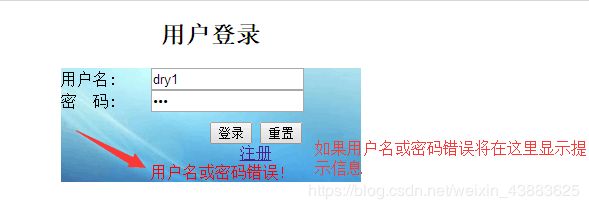java web利用servlet+JDBC实现用户登录
1、登录的一般流程为在后台获取前台传来的登录名和密码
2、利用select语句遍历用户信息表,查找是否存与前台页面传来的用户名和密码相等的值,若存在则登录成功,否则给出提示信息。
我使用的编程环境为:数据库:MySQL5.5、服务器:Tomcat8.5,、编程环境eclipse Mars
首先建立一张用户信息表,一共八个字段
CREATE TABLE `db_user` (
`id` int(20) NOT NULL AUTO_INCREMENT,
`userName` varchar(50) DEFAULT NULL,
`password` varchar(50) DEFAULT NULL,
`sex` varchar(6) DEFAULT NULL,
`birthday` varchar(20) DEFAULT NULL,
`email` varchar(50) DEFAULT NULL,
`phone` varchar(20) DEFAULT NULL,
`address` varchar(200) DEFAULT NULL,
PRIMARY KEY (`id`)
) ENGINE=InnoDB AUTO_INCREMENT=14 DEFAULT CHARSET=utf8
package cn.dry.entity;
public class User {
private int id;//用户编号
private String userName;//用户名
private String password;//密码
private String sex;//性别
private String birthday;//出生日期
private String email;//邮箱
private String phone;//电话
private String address;//地址
public User(){
super();
}
public User (String userName,String password){
super();
this.userName = userName;
this.password = password;
}
public int getId() {
return id;
}
public void setId(int id) {
this.id = id;
}
public String getUserName() {
return userName;
}
public void setUserName(String userName) {
this.userName = userName;
}
public String getPassword() {
return password;
}
public void setPassword(String password) {
this.password = password;
}
public String getSex() {
return sex;
}
public void setSex(String sex) {
this.sex = sex;
}
public String getBirthday() {
return birthday;
}
public void setBirthday(String birthday) {
this.birthday = birthday;
}
public String getEmail() {
return email;
}
public void setEmail(String email) {
this.email = email;
}
public String getPhone() {
return phone;
}
public void setPhone(String phone) {
this.phone = phone;
}
public String getAddress() {
return address;
}
public void setAddress(String address) {
this.address = address;
}
}
数据库连接工具类代码
package cn.dry.util;
import java.sql.Connection;
import java.sql.DriverManager;
public class DbUtil {
private String dbUrl="jdbc:mysql://localhost:3306/数据库名?useUnicode=true&characterEncoding=UTF-8";
private String dbUserName="root";
private String dbPassword="你的数据库连接密码";
private String jdbcName="com.mysql.jdbc.Driver";
/**
* 获取数据库连接
* @return
* @throws Exception
*/
public Connection getCon() throws Exception{
Class.forName(jdbcName);
Connection con=DriverManager.getConnection(dbUrl,dbUserName,dbPassword);
return con;
}
/**
* 关闭数据库连接
* @param con
* @throws Exception
*/
public void closeCon(Connection con) throws Exception{
if(con!=null){
con.close();
}
}
public static void main(String[] args) {
DbUtil dbUtil=new DbUtil();
try {
dbUtil.getCon();
System.out.println("数据库连接成功");
} catch (Exception e) {
// TODO Auto-generated catch block
e.printStackTrace();
}
}
}
字符串验证工具类代码
package cn.dry.util;
public class StringUtil {
public static boolean isEmpty(String str){
if("".equals(str)|| str==null){
return true;
}else{
return false;
}
}
public static boolean isNotEmpty(String str){
if(!"".equals(str)&&str!=null){
return true;
}else{
return false;
}
}
}
登录的DAO代码,就一个登录的方法,从数据库里查询用户名和密码
package cn.dry.model;
import java.sql.Connection;
import java.sql.PreparedStatement;
import java.sql.ResultSet;
import cn.dry.entity.User;
import cn.dry.util.DbUtil;
public class UserDao {
/**
* 登录验证
* @param con
* @param user
* @return
* @throws Exception
*/
public User login(Connection con,User user) throws Exception{
User resultUser=null;
String sql="select * from db_user where userName=? and password=?";
PreparedStatement pstmt=con.prepareStatement(sql);
pstmt.setString(1, user.getUserName());
pstmt.setString(2, user.getPassword());
ResultSet rs=pstmt.executeQuery();
if(rs.next()){
resultUser=new User();
resultUser.setUserName(rs.getString("userName"));
resultUser.setPassword(rs.getString("password"));
}
return resultUser;
}
}
登录的servlet类代码
package cn.dry.web;
import java.io.IOException;
import java.sql.Connection;
import java.text.SimpleDateFormat;
import java.util.ArrayList;
import java.util.Date;
import javax.servlet.ServletContext;
import javax.servlet.ServletException;
import javax.servlet.http.HttpServlet;
import javax.servlet.http.HttpServletRequest;
import javax.servlet.http.HttpServletResponse;
import javax.servlet.http.HttpSession;
import cn.dry.entity.Message;
import cn.dry.entity.User;
import cn.dry.model.UserDao;
import cn.dry.util.DbUtil;
import cn.dry.util.StringUtil;
/**
* Servlet implementation class AddMessageServlet
*/
public class LoginServlet extends HttpServlet {
private static final long serialVersionUID = 1L;
DbUtil dbUtil=new DbUtil();
UserDao userDao=new UserDao();
/**
* @see HttpServlet#HttpServlet()
*/
public LoginServlet() {
super();
// TODO Auto-generated constructor stub
}
/**
* @see HttpServlet#doGet(HttpServletRequest request, HttpServletResponse response)
*/
protected void doGet(HttpServletRequest request, HttpServletResponse response) throws ServletException, IOException {
this.doPost(request, response);
}
/**
* @see HttpServlet#doPost(HttpServletRequest request, HttpServletResponse response)
*/
protected void doPost(HttpServletRequest request, HttpServletResponse response) throws ServletException, IOException {
request.setCharacterEncoding("UTF-8");
response.setCharacterEncoding("UTF-8");
String userName = request.getParameter("userName");//获取用户名
String password = request.getParameter("password");//获取密码
//将集合对象保存到应用上下文中
request.setAttribute("userName", userName);
request.setAttribute("password", password);
//判断用户名和密码是否为空
if(StringUtil.isEmpty(userName)||StringUtil.isEmpty(password)){
request.setAttribute("error", "用户名或密码为空!");
//如果用户名和密码为空则重定向到登录页面
request.getRequestDispatcher("login.jsp").forward(request, response);
return;
}
//实例化user类
User user = new User(userName,password);
Connection con = null;
try {
con = dbUtil.getCon();
User currentUser = userDao.login(con, user);
//判断用户名、
if(currentUser==null){
request.setAttribute("error", "用户名或密码错误!");
//服务器端跳转
request.getRequestDispatcher("login.jsp").forward(request, response);
}else{
//获取session对象
HttpSession session = request.getSession();
session.setAttribute("currentUser", currentUser);
//客户端跳转
response.sendRedirect("index.jsp");
}
} catch (Exception e) {
// TODO Auto-generated catch block
e.printStackTrace();
}finally {
try {
dbUtil.closeCon(con);
} catch (Exception e2) {
e2.printStackTrace();
}
}
}
}
前台登录页面代码,不是专业的美工,页面做的不是很美观。
<%@ page language="java" contentType="text/html; charset=UTF-8"
pageEncoding="UTF-8"%>
<html>
<head>
<meta http-equiv="Content-Type" content="text/html; charset=UTF-8">
<title>用户登录title>
<style type="text/css">
#userlogin{
height:200px;
border-top:60px;
border-bottom: 20px;
}
style>
head>
<body>
<div id="userlogin" align="center" >
<h2>用户登录h2>
<form action="LoginServlet" method="post">
<table border="0" cellpadding="0" cellspacing="0" background="images/userlogin.jpg" width="300" >
<tr>
<td>用户名:td>
<td><input type="text" name="userName" id="userName" value="${userName }"> td>
tr>
<tr>
<td>密 码:td>
<td><input type="password" name="password" id="password" value="${password }"> td>
tr>
<tr>
<td height="10">td>
tr>
<tr>
<td>td>
<td colspan="2" align="center">
<input type="submit" value="登录">
<input type="reset" value="重置">
td>
tr>
<tr>
<td>td>
<td colspan="2" align="center"><a href="register.jsp">注册a> td>
tr>
<tr height="20">
<td width="30%">td>
<td colspan="2">
<font color="red">${error }font>**//这里是显示用户登录错误的提示信息,利用EL表达式从后台传值,实现在前台显示。**
td>
tr>
<tr >
<td>td>
tr>
table>
form>
div>
body>
html>
用servlet实现登录时必须配置相应的web.xml文件,只有路径置正确才能正确访问。

最后是前台的登录效果

花了一个晚上搞出来的,前台界面不是很美观,可以自己微调,希望能帮到大家,有问题欢迎留言。
